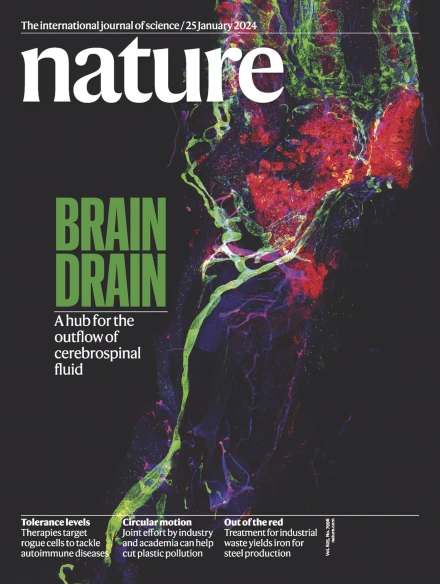丙酸咪唑是动脉粥样硬化的驱动因子和治疗靶点
IF 48.5
1区 综合性期刊
Q1 MULTIDISCIPLINARY SCIENCES
引用次数: 0
摘要
动脉粥样硬化是心血管疾病的主要潜在原因。其预防是基于传统心血管危险因素的检测和治疗1。然而,有早期血管疾病风险的个体往往不为人所知。最近的研究发现了动脉粥样硬化病理生理学中的新分子,强调需要替代疾病生物标志物和治疗靶点来提高早期诊断和治疗效果。在这里,我们观察到微生物产生的咪唑丙酸酯(ImP)与小鼠和两个独立的人类队列中的动脉粥样硬化程度有关。此外,给易发动脉粥样硬化的小鼠注射ImP足以诱导动脉粥样硬化,而不改变脂质谱,并且与全身和局部先天和适应性免疫和炎症的激活有关。具体来说,我们发现ImP通过髓细胞中的咪唑啉-1受体(I1R,也称为nischarin)引起动脉粥样硬化。阻断这条ImP - i1r轴可抑制小鼠由ImP或高胆固醇饮食诱导的动脉粥样硬化的发展。发现ImP与活动性动脉粥样硬化的强相关性以及ImP - i1r轴对疾病进展的贡献,为改善动脉粥样硬化的早期诊断和个性化治疗开辟了新的途径。本文章由计算机程序翻译,如有差异,请以英文原文为准。


Imidazole propionate is a driver and therapeutic target in atherosclerosis
Atherosclerosis is the main underlying cause of cardiovascular diseases. Its prevention is based on the detection and treatment of traditional cardiovascular risk factors1. However, individuals at risk for early vascular disease often remain unidentified2. Recent research has identified new molecules in the pathophysiology of atherosclerosis3, highlighting the need for alternative disease biomarkers and therapeutic targets to improve early diagnosis and therapy efficacy. Here, we observed that imidazole propionate (ImP), produced by microorganisms, is associated with the extent of atherosclerosis in mice and in two independent human cohorts. Furthermore, ImP administration to atherosclerosis-prone mice fed with chow diet was sufficient to induce atherosclerosis without altering the lipid profile, and was linked to activation of both systemic and local innate and adaptive immunity and inflammation. Specifically, we found that ImP caused atherosclerosis through the imidazoline-1 receptor (I1R, also known as nischarin) in myeloid cells. Blocking this ImP–I1R axis inhibited the development of atherosclerosis induced by ImP or high-cholesterol diet in mice. Identification of the strong association of ImP with active atherosclerosis and the contribution of the ImP–I1R axis to disease progression opens new avenues for improving the early diagnosis and personalized therapy of atherosclerosis. Imidazole propionate produced by gut microbiota is associated with atherosclerosis in mouse models and in humans, and causes the development of atherosclerosis through activation of the imidazoline-1 receptor in myeloid cells.
求助全文
通过发布文献求助,成功后即可免费获取论文全文。
去求助
来源期刊

Nature
综合性期刊-综合性期刊
CiteScore
90.00
自引率
1.20%
发文量
3652
审稿时长
3 months
期刊介绍:
Nature is a prestigious international journal that publishes peer-reviewed research in various scientific and technological fields. The selection of articles is based on criteria such as originality, importance, interdisciplinary relevance, timeliness, accessibility, elegance, and surprising conclusions. In addition to showcasing significant scientific advances, Nature delivers rapid, authoritative, insightful news, and interpretation of current and upcoming trends impacting science, scientists, and the broader public. The journal serves a dual purpose: firstly, to promptly share noteworthy scientific advances and foster discussions among scientists, and secondly, to ensure the swift dissemination of scientific results globally, emphasizing their significance for knowledge, culture, and daily life.
 求助内容:
求助内容: 应助结果提醒方式:
应助结果提醒方式:


